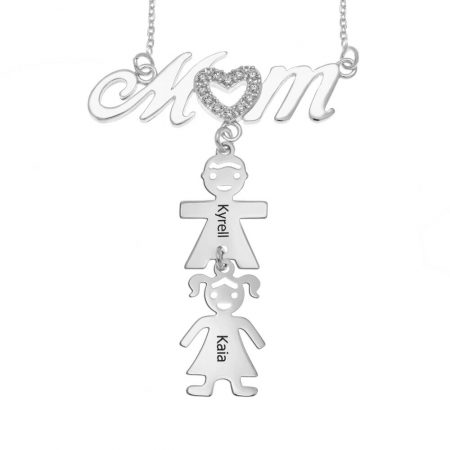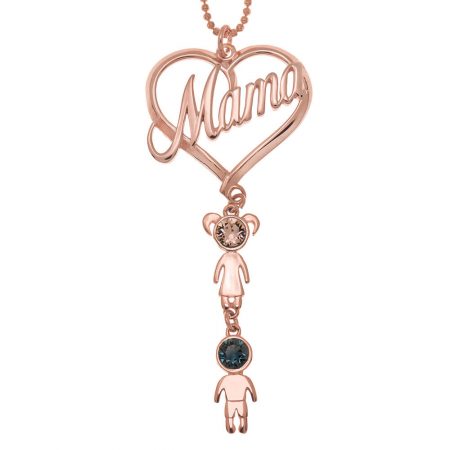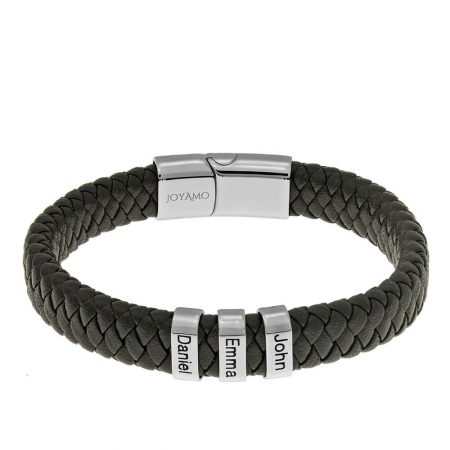Are you wondering if your necklace is real gold or a clever imitation? Determining the authenticity of gold jewelry can be tricky, but fear not!
Let’s explore foolproof methods to help you distinguish between genuine gold and its counterfeit counterparts.
Deciphering the Authenticity of Gold
✍🏻 The History of Gold
Gold has a history that spans thousands of years and is valued by cultures as a symbol of prosperity, influence, and attractiveness.
Its appeal can be traced back, to eras when it was highly prized for its rarity and shine.
From the decorations of rulers to the fabled riches of El Dorado, gold has captured people’s imaginations and motivated exploration and conquest.
Throughout history, gold has functioned as a form of currency, facilitating trade and business dealings across regions.
The discovery of gold deposits led to gold rushes that shaped the landscapes and economies of territories and countries.
With time, gold continues to play a role in worldwide financial systems, acting as a safeguard against economic fluctuations and uncertainty.
Its enduring charm transcends time, serving as evidence of humanity’s fascination with this metal.
This radiant metal, cherished for its appeal, holds a position in religious observances and family customs throughout society.
From bustling cities to communities, the significance of gold is ever present, intricately intertwined with societal norms.
Every possession of gold represents value and also carries a deep heritage filled with traditions often passed down through generations as beloved family treasures.
Despite the regard and widespread desire for gold, there exists a market that operates globally, selling fake and impure forms of this valuable metal.
Global standards dictate that anything below 10 karats or with more than 41.7% gold content is deemed counterfeit.
When navigating the realm of investments, it is crucial to determine the legitimacy of one’s assets.
This detailed guide aims to shed light on the methods and examinations used to confirm the authenticity of gold, differentiating between treasures and mere replicas.
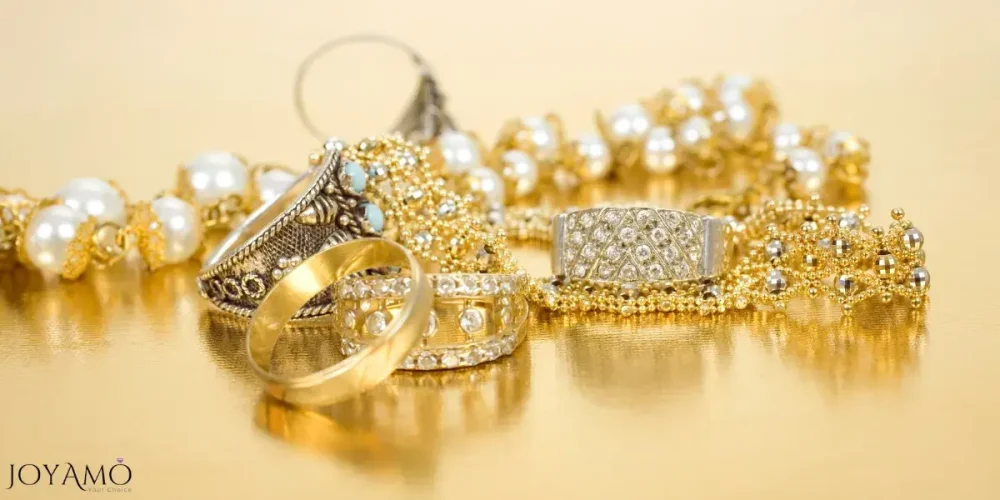
Methods to Ascertain the Authenticity of Gold
✍🏻 8 Ways to tell if your gold necklace is real
📌 Hallmark Examination
When buying gold jewelry, a hallmark stamp engraved on the piece is a pivotal indicator of its purity and provenance. These stamps, rooted in the standards of karats and millesimal fineness, provide invaluable insights into the composition of the gold. While hallmarking offers a reliable initial assessment, it is essential to acknowledge its limitations, as counterfeiters may replicate these stamps. The absence of a hallmark does not necessarily denote falsity, as wear and tear over time may obscure or erode these markings. Consulting with a reputable jeweler is important to verify authenticity.
📌 Vinegar Test
A simple application of vinegar serves as a preliminary means of assessing gold’s authenticity. Genuine gold remains unaltered upon exposure to vinegar, while counterfeit specimens may undergo discoloration or corrosion, indicative of their fraudulent composition.
📌 Letter Markings Examination
Beyond hallmark stamps, letter markings on gold jewelry have essential information regarding its composition and origin. Abbreviations such as GP (Gold Plated), GF (Gold Filled), or GE (Gold Electroplated) signify variations in gold content and manufacturing processes. Understanding these markings facilitates the comprehension of the gold’s authenticity, aiding in the identification of degraded or plated pieces.
📌 Skin Rubbing Test
A rudimentary yet revealing test involves rubbing the gold against one’s skin. Authentic gold, with its inert properties, leaves the skin unaltered. In contrast, counterfeit gold may impart discoloration, manifesting as black, blue, or green hues. However, it is essential to conduct this test on clean, makeup-free skin to ensure accurate results.
📌 Water Displacement Test
Utilizing the principle of density, the water displacement test provides a straightforward way of discerning genuine gold from its counterfeit counterparts. Authentic gold, having a higher density than water, promptly sinks upon immersion. Conversely, counterfeit gold may exhibit buoyancy, remaining afloat or suspended within the water medium, showing its falsity.
📌 Size and Weight Comparison
Comparing the size and weight of gold pieces against established benchmarks provides validation of their authenticity. Discrepancies in weight relative to size may indicate counterfeit compositions, prompting a more thorough examination using specialized jewelry tools such as calipers and Fisch testers. This method, particularly effective for coins and bars, ensures meticulous scrutiny of gold acquisitions.
📌 Magnetism Examination
Gold, being inherently non-magnetic, exhibits no attraction when subjected to a strong magnetic field. By contrast, counterfeit gold or gold-plated alloys may demonstrate magnetic properties, betraying their fraudulent nature. While this test offers valuable insights, it is not foolproof, necessitating supplementary examinations to corroborate the findings.
📌 Ceramic Tile Scrape Test
Checking gold against an unglazed ceramic surface reveals its authenticity, as genuine gold leaves behind distinctive markings but counterfeit metals may produce black residue upon scraping. This tactile examination offers tangible evidence of the gold’s composition, aiding in the swift identification of fraudulent specimens.
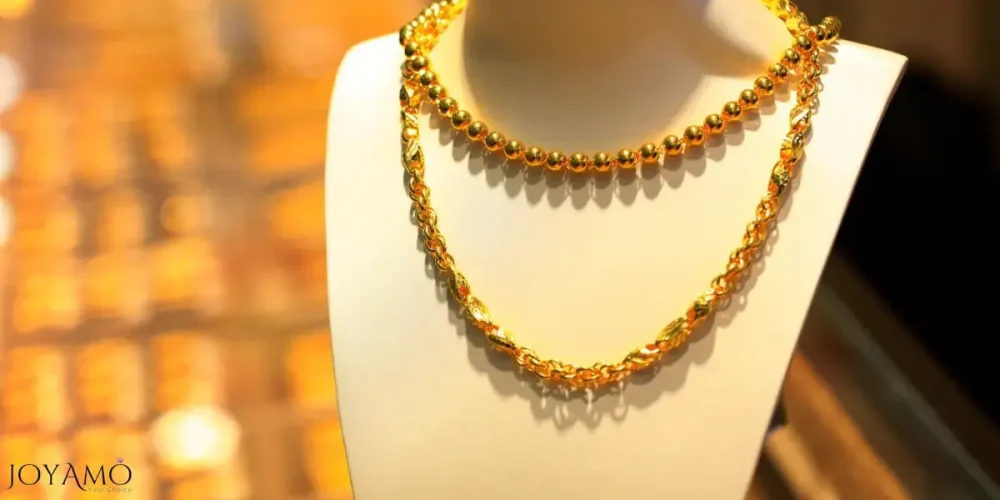
Using a multifaceted approach encompassing hallmark examination, letter marking analysis and tactile tests allows individuals to safeguard their investments and preserve the integrity of their cherished gold possessions.
Following these rigorous methodologies, one can navigate the world of gold acquisitions with confidence and clarity, ensuring that every acquisition is a genuine treasure worthy of its esteemed legacy.
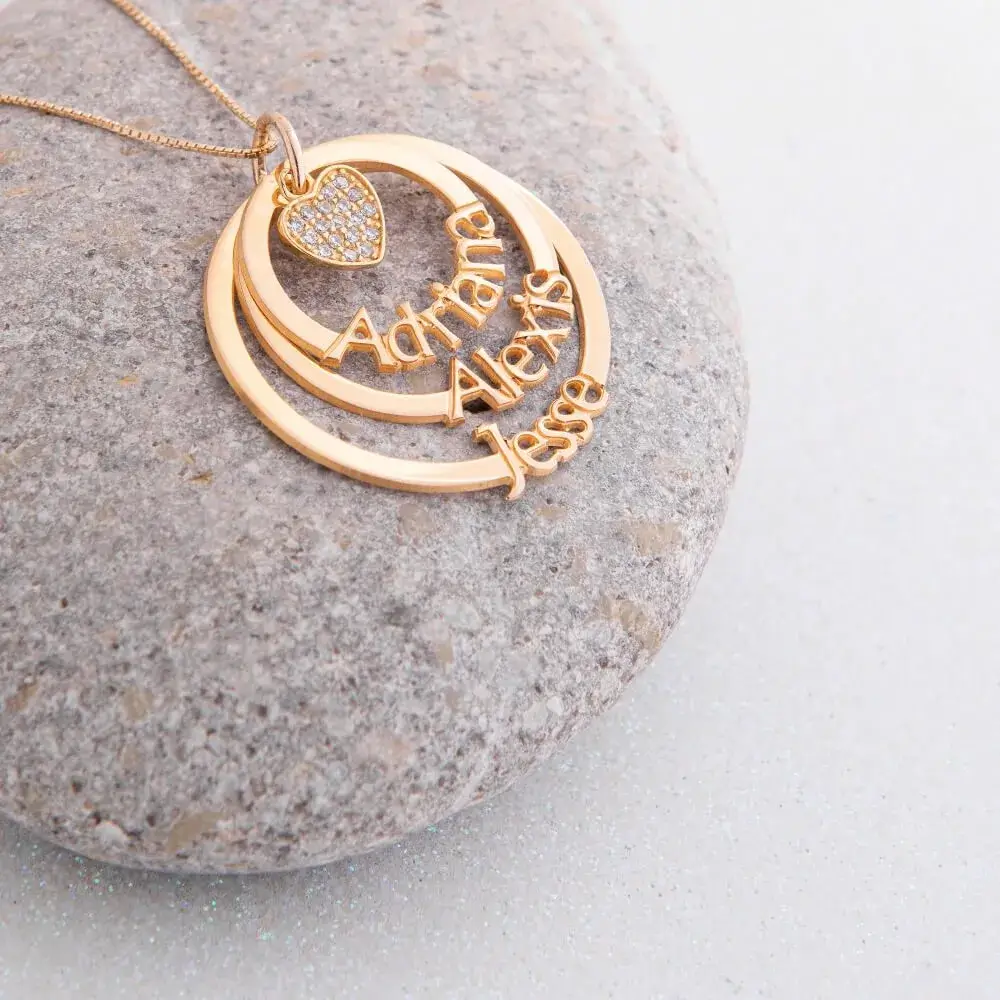
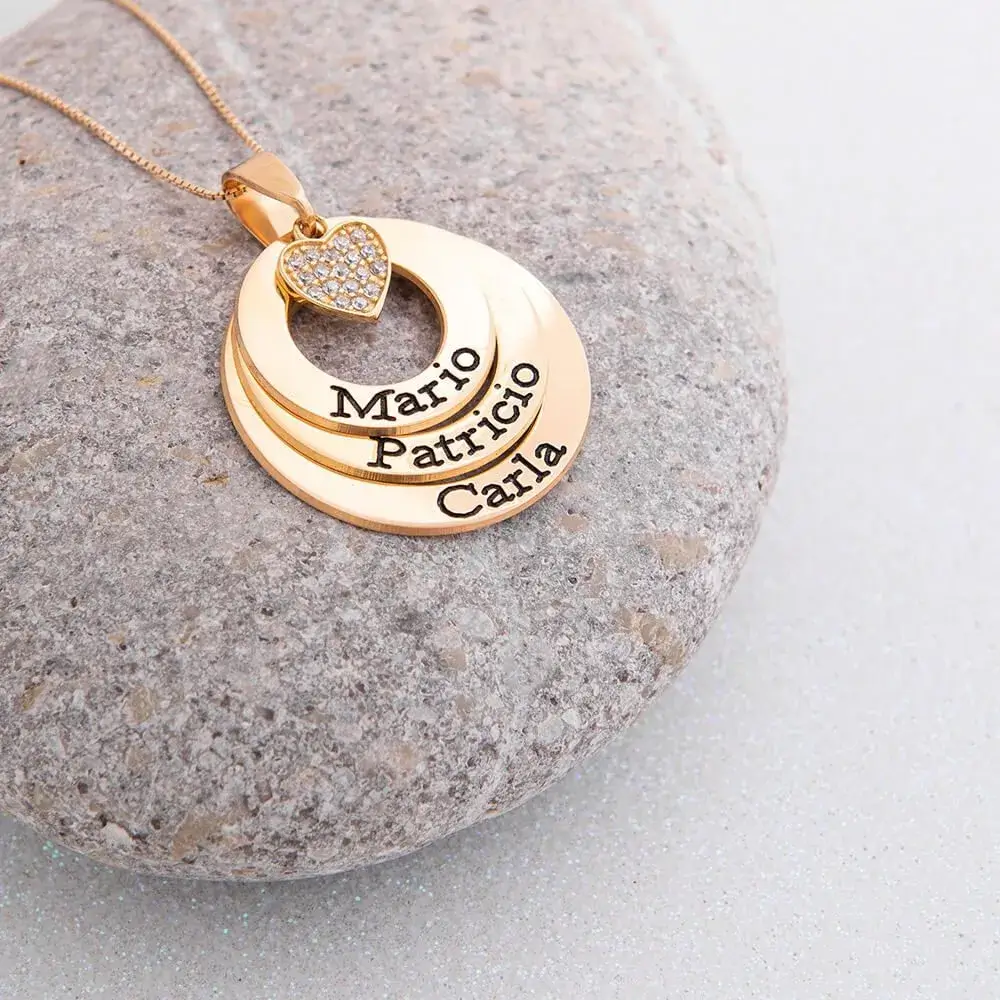
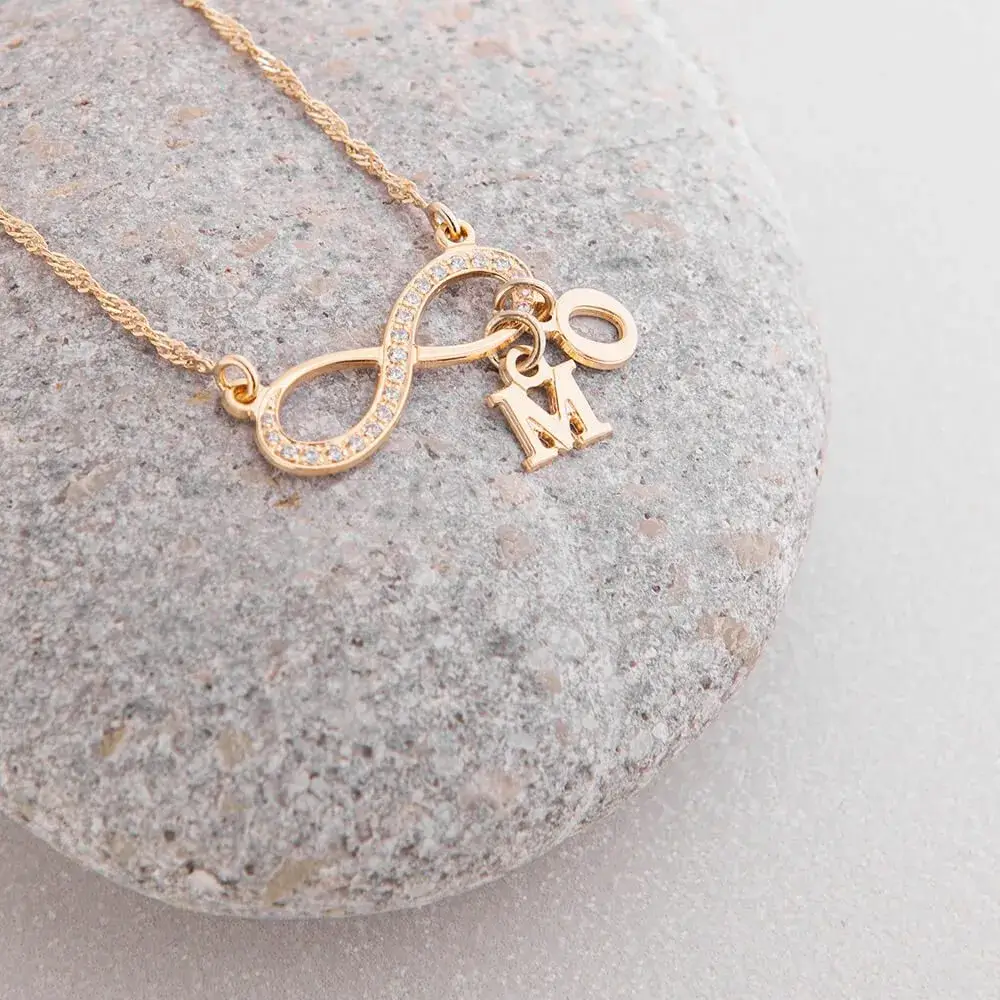
Choosing the Right Solid Gold:
Comparing 10K, 14K, 18K, 22K and 24K
When you select your ideal solid gold jewelry piece, the choice of metal is pivotal, influencing aesthetics and practicality.
Gold, available in 10K, 14K, 18K, and 24K variants, offers a spectrum of options with distinct characteristics.
Understanding the nuances of each karat is crucial for making an informed decision according to your preferences and lifestyle.
👉🏻 What is a Karat? Assessing Gold Purity
Gold purity is indicated in karats, abbreviated as K, showing the proportion of pure gold within the alloy. While pure gold is expressed as 24K, the presence of other metals reduces the karat value.
Below is a breakdown of the purity levels associated with each karat:
| Karat | Purity Level (%) | Characteristics |
|---|---|---|
| 24K | 100% | Pure gold, soft, rich yellow-orange hue |
| 18K | 75% | High purity, durable, warm golden color |
| 14K | 58.3% | Durable, classic gold appearance |
| 10K | 41.7% | Least pure, most durable, pale yellow color |
👉🏻 Comparing Different Karats of Gold
22K Gold
- Pros: Close to pure gold, bright yellow color
- Cons: Not suitable for gemstone settings
18K Gold
- Pros: Highest practical purity, rich golden hue
- Cons: Expensive, prone to scratching
14K Gold
- Pros: Durable, classic appearance, good value
- Cons: Possible skin irritation for some individuals
10K Gold
- Pros: Very durable, affordable
- Cons: More alloyed metals, pale yellow color, potential for skin issues
Each karat level offers distinct advantages and considerations, catering to varied preferences and requirements.
Prioritizing purity, durability, or budget, empowers you to select the perfect gold for your engagement ring.
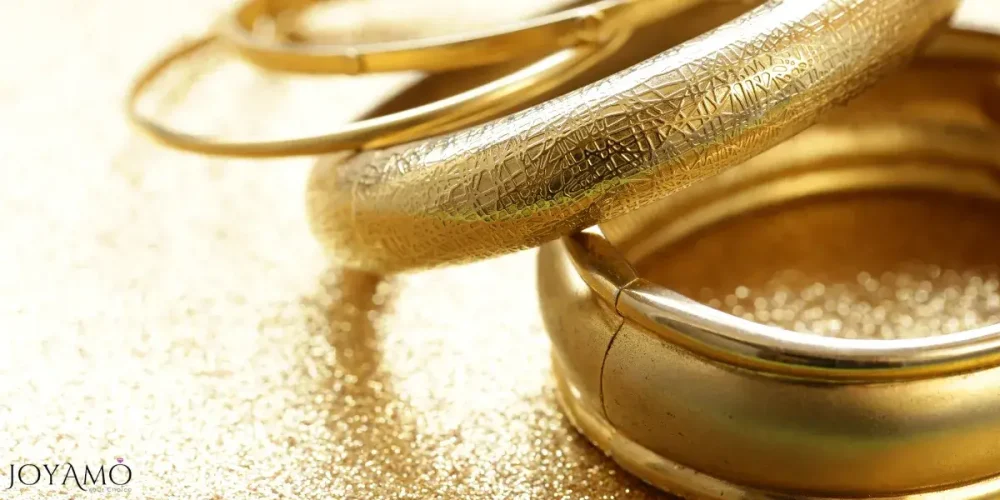
SOLID GOLD VS GOLD PLATED: HOW TO SPOT THE DIFFERENCES
Distinguishing between solid gold and gold plated pieces is crucial for informed jewelry purchases. Solid gold consists of pure gold throughout, while gold plated items feature a thin layer of gold over a base metal.
To discern between the two, several methods can be employed. Firstly, examine for hallmarks or stamps indicating purity on solid gold jewelry, whereas gold plated pieces may feature markings like “GP” or “GF.”
Additionally, inspect the item’s surface for signs of wear or tarnishing, as gold plated pieces may reveal the underlying metal over time.
Conducting a simple scratch test on a discreet area can also provide insight, as solid gold maintains its color, whereas gold plated surfaces may reveal a different metal underneath.
By employing these techniques, consumers can confidently differentiate between solid gold and gold plated jewelry, ensuring they make informed purchasing decisions.
Differences between solid gold and gold plated jewelry
| Feature | Solid Gold | Gold Plated |
|---|---|---|
| Composition | It consists of pure gold throughout | A Thin layer of gold over a base metal |
| Purity | Higher purity levels (e.g., 18k, 24k) | Lower purity levels (e.g., 10k, 14k) |
| Durability | More durable and resistant to tarnishing | Less durable and prone to tarnishing over time |
| Price | Generally more expensive | More affordable |
| Maintenance | Requires minimal maintenance | A thin layer of gold over a base metal |
| Appearance | Maintains its color and luster over time | May fade or wear off with frequent use |
| Hallmarks/Markings | Typically stamped with purity marks | May feature markings like “GP” or “GF” |
| Weight | Heavier due to higher gold content | Lighter due to the thin layer of gold |
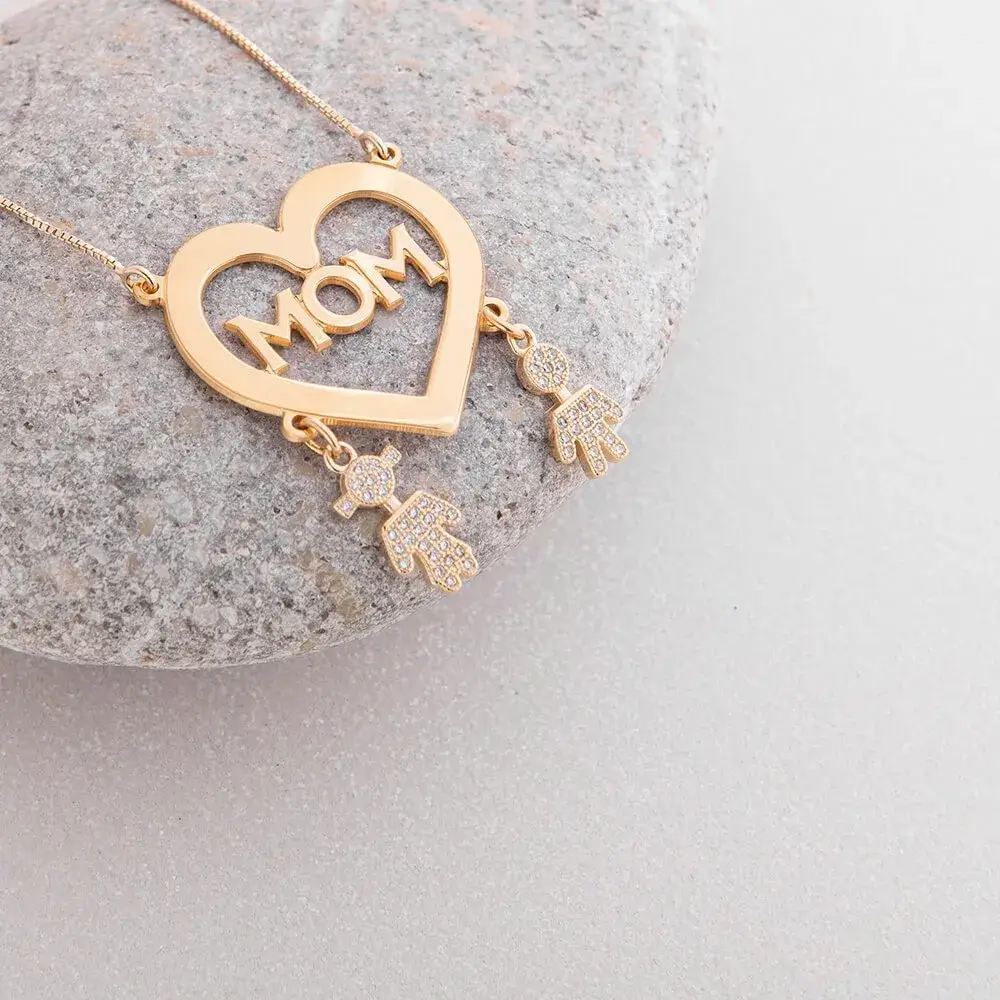
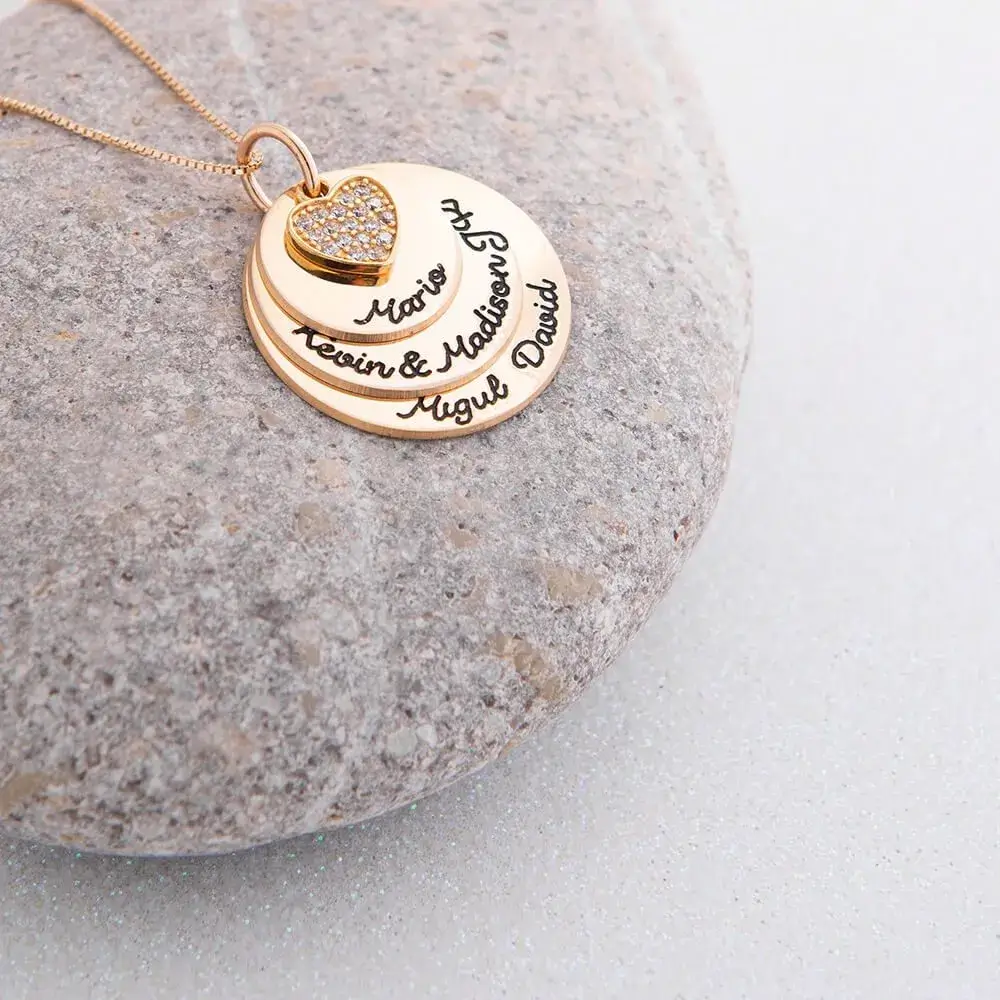
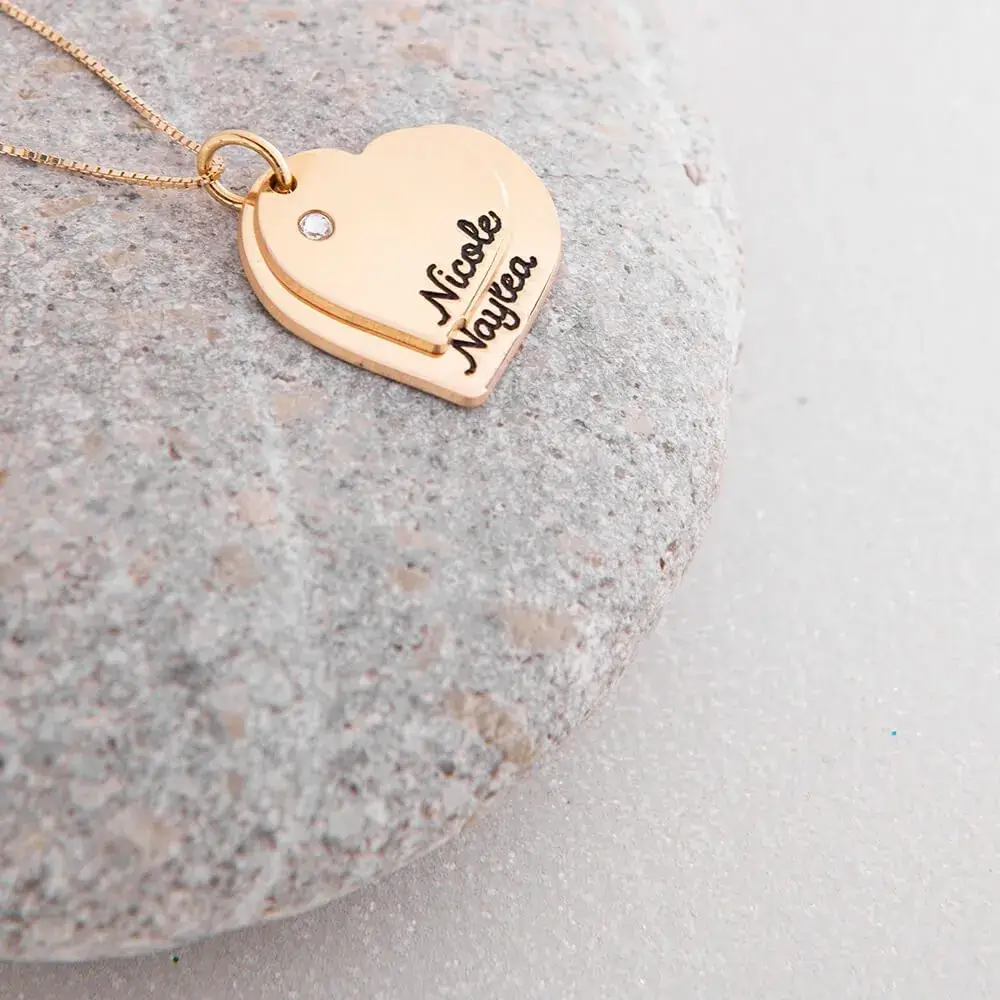
✍🏻 The history of gold in jewelry
Throughout history, gold has always been highly esteemed in the realm of jewelry, symbolizing riches, influence, and beauty across a variety of cultures and societies.
The fascination with gold can be traced back to eras when it was considered a metal with divine attributes.
One of the known instances of using gold in jewelry dates back to Egypt around 3000 BCE.
The Egyptians viewed gold as the flesh of deities. Extensively utilized it in ceremonies to adorn the departed with intricate jewelry believing it would accompany them into the afterlife.
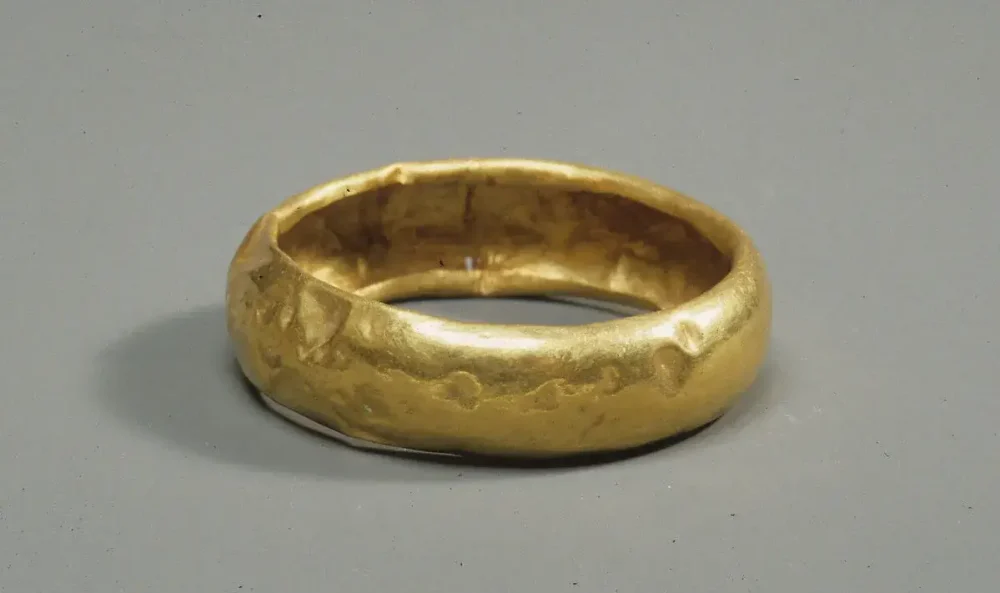
Early Dynastic Period
ca. 2650 B.C.
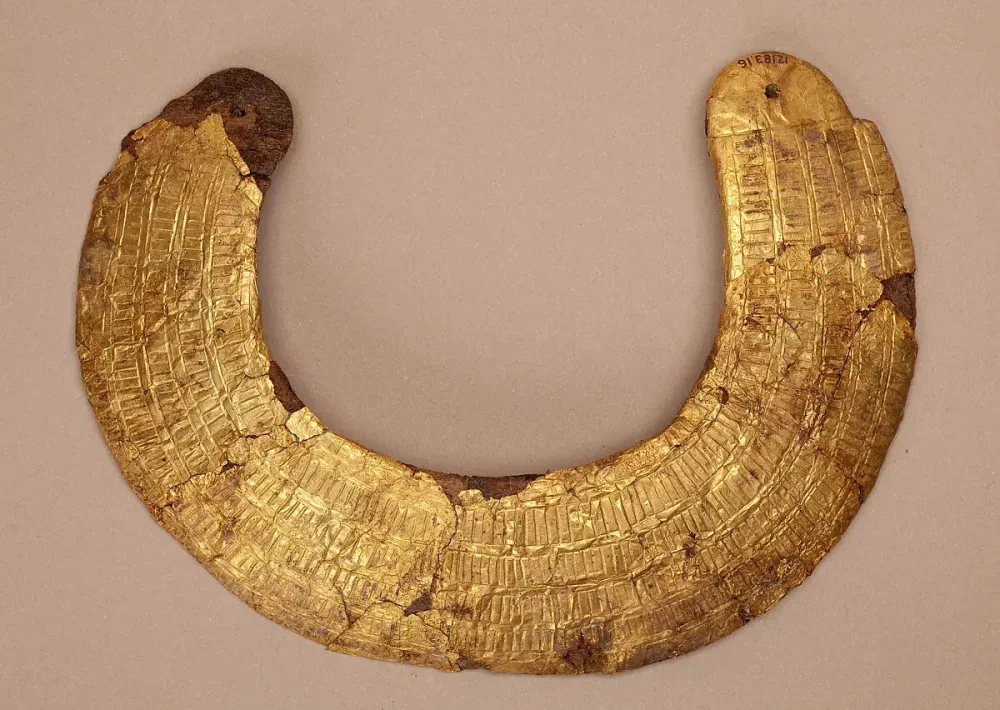
Middle Kingdom
ca. 1981–1802 B.C.
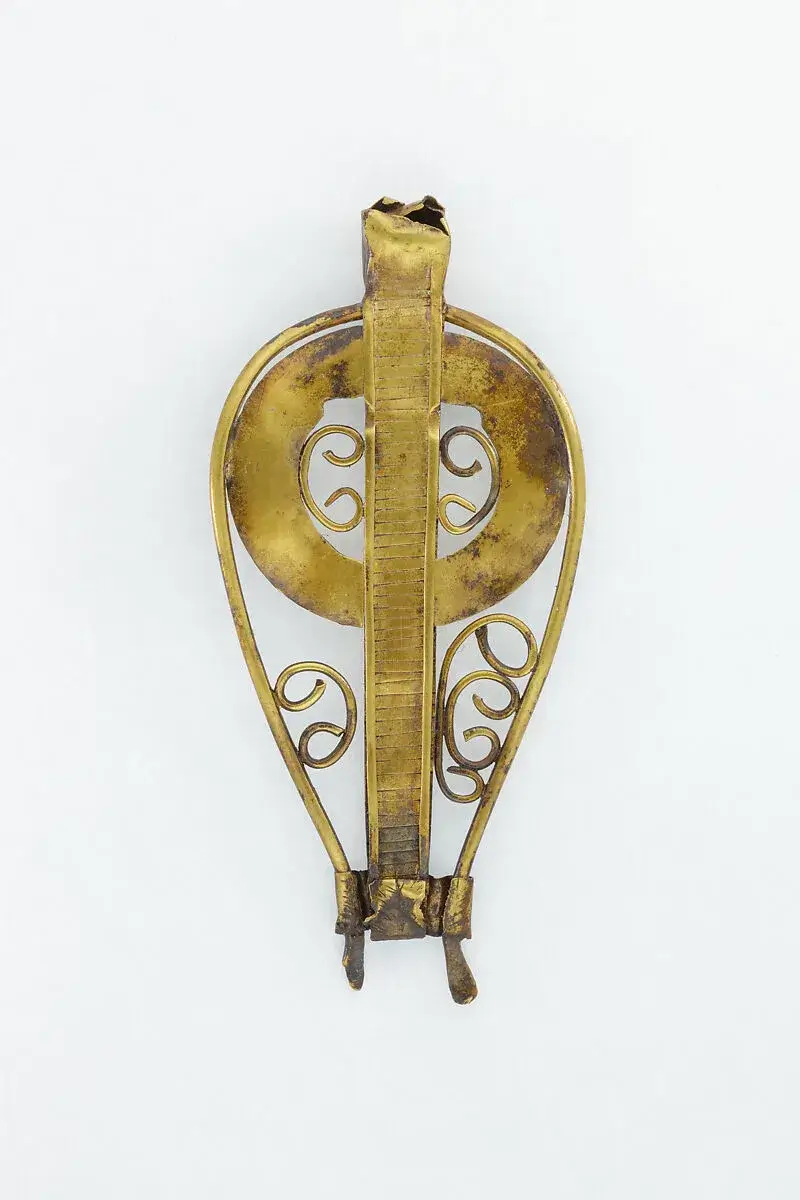
Middle Kingdom
2030–1650 B.C.
The artistry of crafting gold jewelry reached levels during the Roman eras.
Goldsmiths in these civilizations honed techniques like filigree, granulation, and repoussé producing designs that embellished both men and women of standing.
Gold became synonymous with extravagance and wealth adorning royalty and nobles as crowns, necklaces, bracelets, and rings.
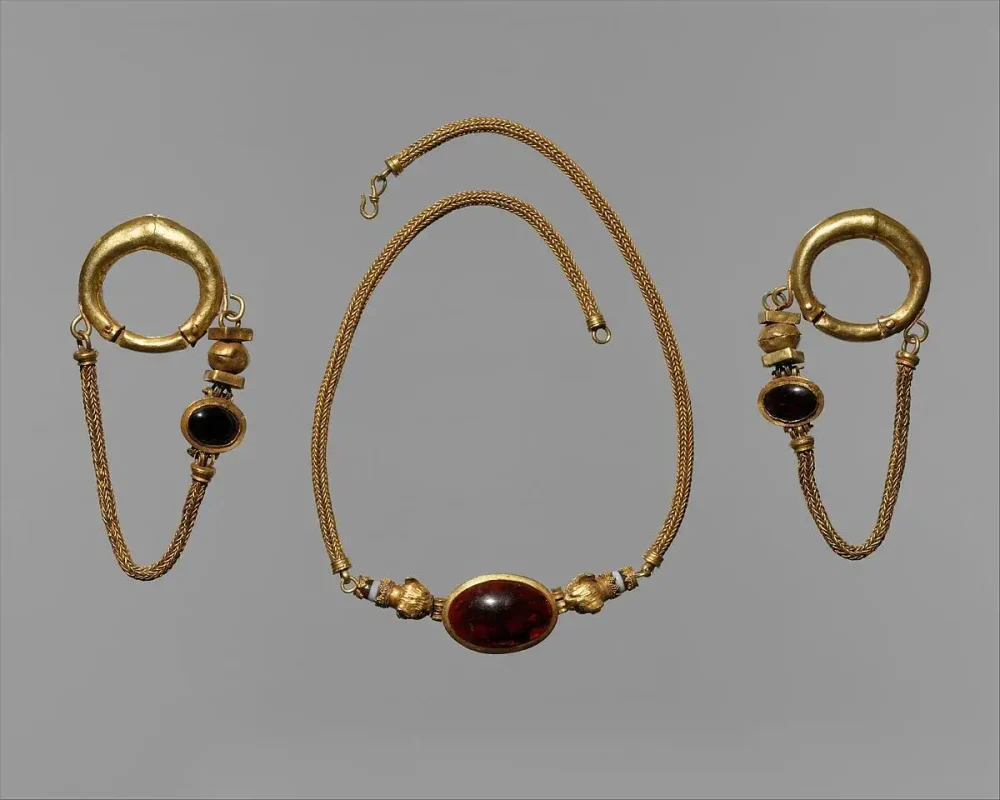
1st century BCE
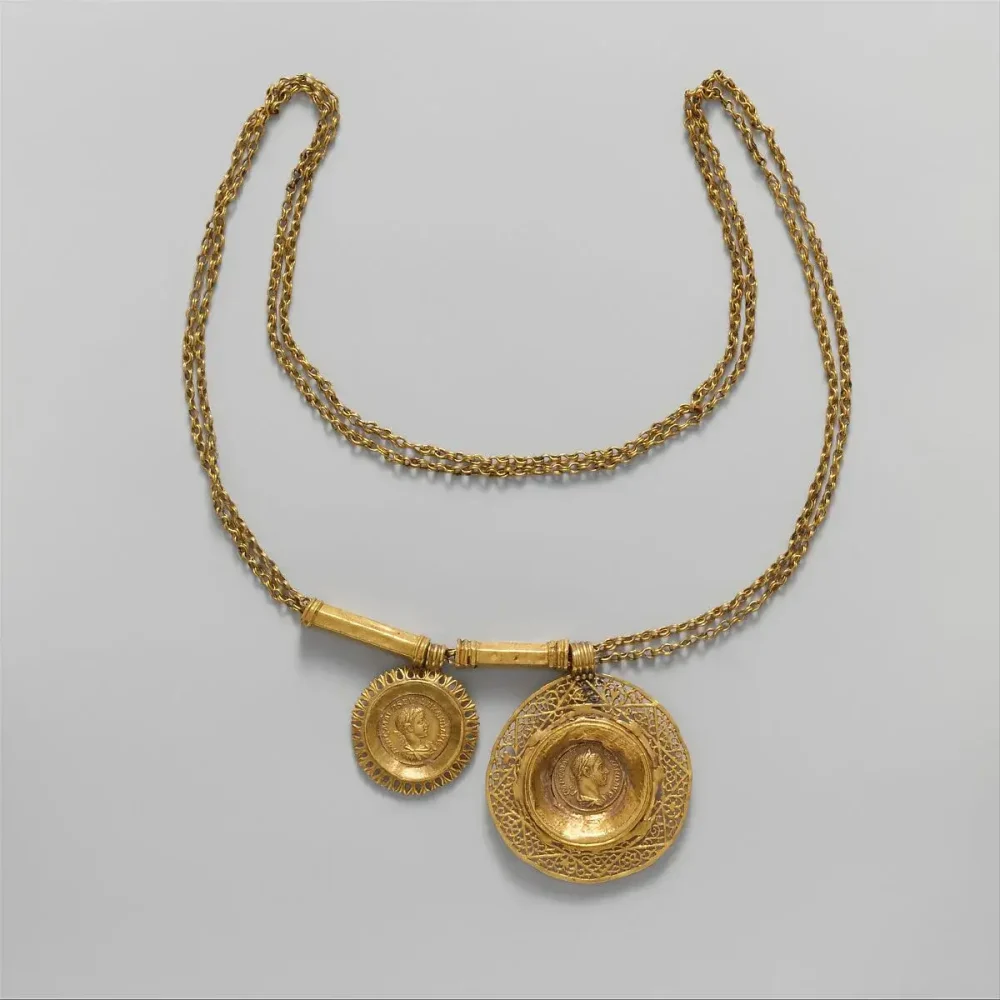
3rd century CE

ca. 200 BCE
In Europe guilds dedicated to goldsmithing emerged that set standards for craftsmanship and quality assurance.
Gold continued to signify affluence and prestige as aristocrats commissioned pieces to showcase their wealth.
The Renaissance era experienced a renewed interest, in art and traditions leading to a revival of jewelry styles.
Goldsmiths found inspiration in the styles of Greece and Rome incorporating detailed patterns and valuable gemstones into their creations.

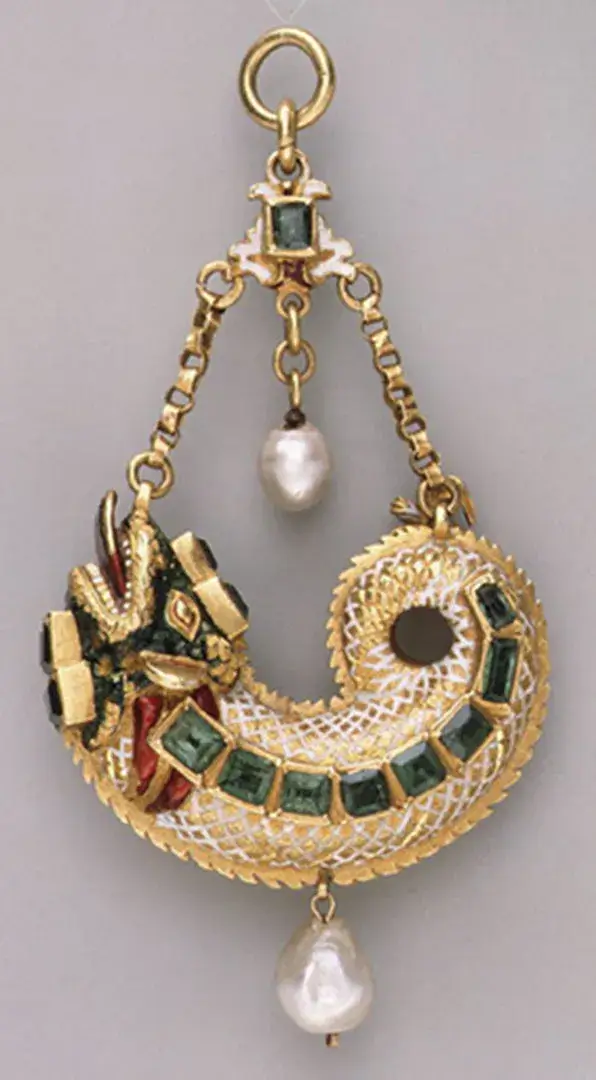
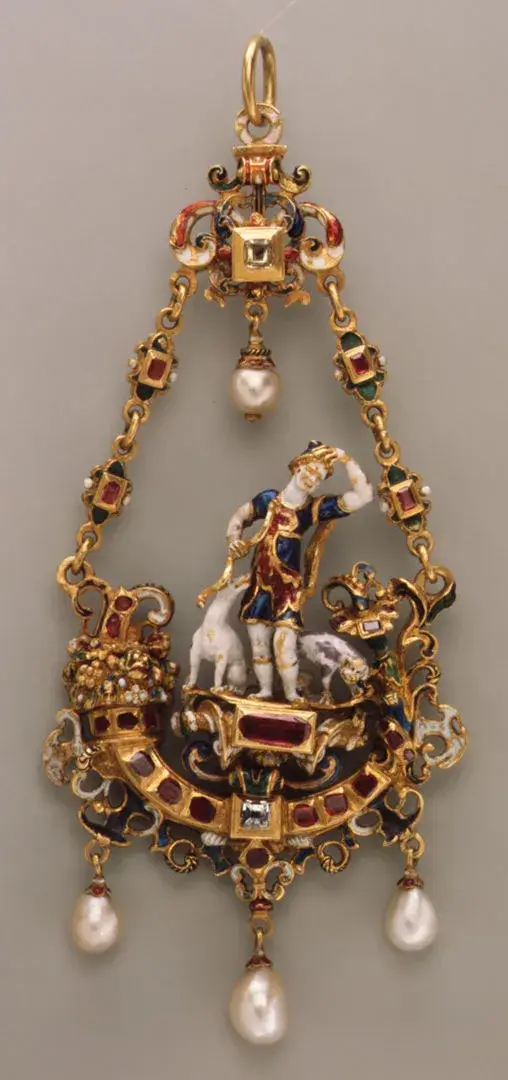
The exploration of the Americas in the 15th century led to an increase in the availability of gold in Europe, which contributed to the growth of empires and the establishment of global trade routes.
While gold jewelry became more accessible to an audience it continued to be associated with wealth and status.
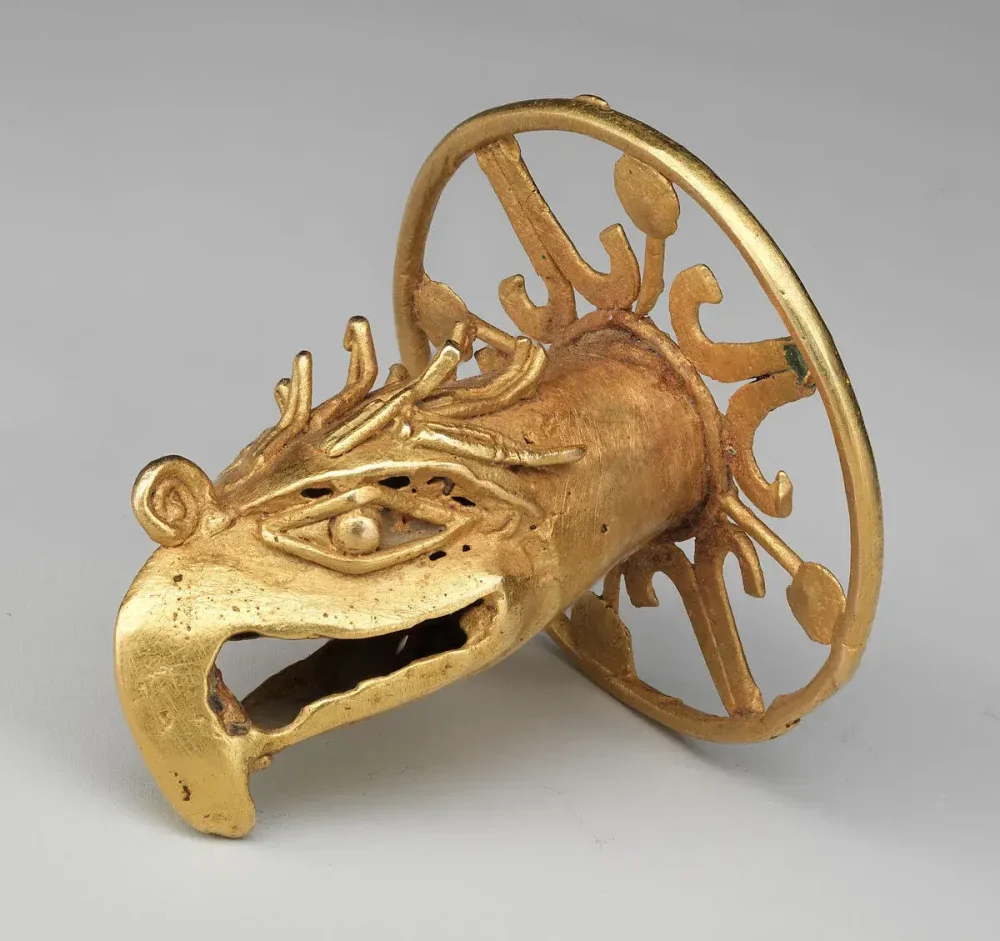
Aztec or Mixtec
15th–early 16th century
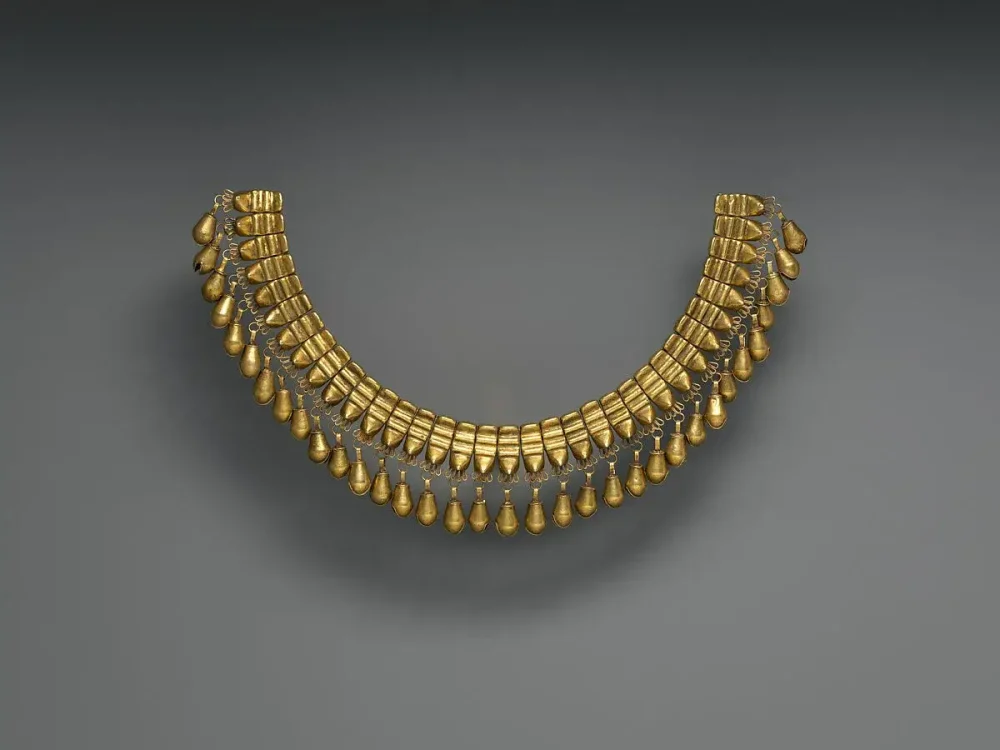
Mixtec (Ñudzavui)
13th–16th century

Aztec or Mixtec
15th–early 16th century
Nowadays, technological advancements have transformed the jewelry industry enabling mass production and innovative design methods.
Despite these developments, gold remains a symbol of grace and refinement valued for its beauty and lasting worth.
Today gold jewelry continues to enchant and motivate people from backgrounds transcending cultural barriers as a treasured keepsake passed down through generations.
Worn as a fashion statement or a sentimental token, gold jewelry holds a spot in the hearts of individuals worldwide embodying centuries-old traditions and skilled craftsmanship.
* All the pics belong to the Collection of Ancient Jewelry of the Metropolitan Museum of Art (MET) of NY
✍🏻 The role of gold in modern Jewelry
Gold remains a player in today’s jewelry scene, effortlessly merging elements with modern flair to produce pieces that radiate grace and style.
Despite its timeless appeal the way gold is used in jewelry reflects shifting preferences, trends, and technological advancements.
The versatility of gold stands out as a defining feature in jewelry.
It can be shaped into an array of designs ranging from simple and chic to bold and expressive appealing to a spectrum of tastes.
18 karat gold, white gold, or rose gold, each type brings its distinct charm giving designers room to explore and create.
Renowned jewelry houses like Tiffany & Co., Cartier, and Bulgari have played roles in elevating the status of gold in today’s jewelry landscape.
Tiffany & Co. known for its enduring sophistication integrates gold into its pieces with precision and artistry often showcasing symbols like the Tiffany T and Atlas collection.
Cartier, synonymous with luxury craftsmanship showcases gold in its Love bracelets, Panthère de Cartier watches, and Trinity rings, by blending artistry with a modern twist.
Bulgari’s vibrant creations feature the use of gold as a backdrop for gemstones in collections like Serpenti and B.zero1, redefining the boundaries of contemporary luxury.
In addition to established luxury brands, emerging designers and artisanal jewelers are redefining the role of gold in modern jewelry
By exploring shapes, textures, and finishes, these creators bring a perspective to gold attracting a new wave of discerning consumers who appreciate individuality and craftsmanship.
Gold goes beyond its appeal in contemporary jewelry.
Its strength and resistance to tarnishing make it a practical choice for wear ensuring that pieces maintain their shine and allure over time.
In summary, gold plays a role in jewelry as a symbol of opulence, creativity, and timeless beauty.
From heritage brands to contemporary artisans, gold continues to spark inspiration and fascination transcending fads and leaving an enduring impact on the world of fashion and design.
✍🏻 Masterpieces of contemporary gold jewelry pieces from iconic brands
| Brand | Piece | Description |
|---|---|---|
| Tiffany & Co. | Tiffany T Bracelet | Sleek and modern bracelet featuring the iconic “T” motif, crafted in 18-karat gold. |
| Cartier | Love Bracelet | Timeless bracelet characterized by its screw motifs, available in various gold finishes. |
| Bulgari | Serpenti Necklace | Striking necklace inspired by the sinuous form of a serpent, crafted in luxurious yellow gold. |
| Van Cleef & Arpels | Alhambra Necklace | Elegant necklace featuring the signature Alhambra motif, crafted in 18-karat gold and gemstones. |
| Chopard | Happy Hearts Bangle | Playful bangle adorned with heart motifs, crafted in rose gold and featuring floating diamond accents. |
| Boucheron | Quatre Radiant Edition Ring | Bold ring featuring the iconic Quatre motif, combining yellow, white, and rose gold in a striking design. |
| Harry Winston | Sunflower Necklace | Exquisite necklace inspired by the radiant beauty of sunflowers, crafted in yellow gold and diamonds. |
| Graff | Icon Multi-Coloured Bracelet | Vibrant bracelet adorned with an array of colored gemstones, set in 18-karat gold. |
| Piaget | Possession Diamond Bracelet | Chic bracelet featuring a rotating diamond-set band, crafted in 18-karat gold. |
| Mikimoto | Morning Dew Pearl Earrings | Elegant earrings showcasing lustrous pearls suspended from delicate gold settings. |
✍🏻 Iconic pieces of modern gold Jewelry
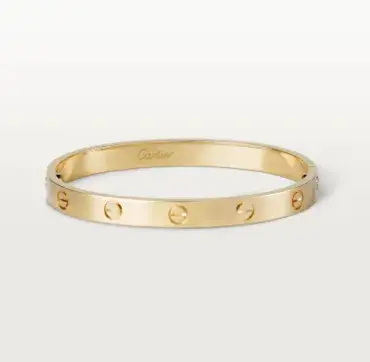

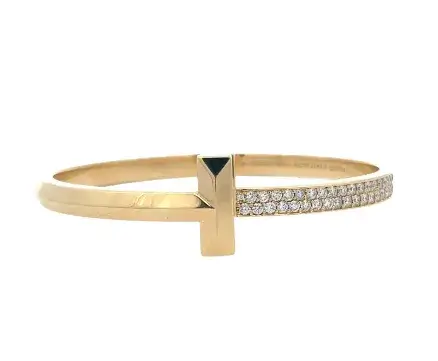
💡 How to spot fake gold jewelry FAQ
✔ How can you tell if a necklace is real gold at home?
You can perform several tests to determine if a necklace is real gold. These include checking for hallmarks or stamps indicating purity, conducting a skin rubbing test to assess discoloration, and using a magnet to gauge its magnetic properties.
✔ How can you tell if a necklace is solid gold or plated?
To discern if a necklace is solid gold or plated, you can examine hallmarks for purity, assess durability and tarnishing, conduct a scratch test on a discreet area, and look for signs of wear or fading over time.
✔ Is the vinegar test for gold accurate?
The vinegar test can provide a preliminary indication of gold’s authenticity. If gold remains unchanged after exposure to vinegar, it suggests authenticity; however, this method may not be foolproof. Other factors, like alloys or surface treatments, can influence results, so it’s best used with other tests.
✔ How can you tell if a gold chain is real with a magnet?
Using a magnet to test gold can offer insights into its authenticity. Real gold is non-magnetic, so if a gold chain is unaffected by a magnet, it suggests authenticity. However, this method isn’t entirely accurate, as some counterfeit gold alloys can also be non-magnetic. Combining this test with others is advisable for a more conclusive assessment.
 SHIPPING
SHIPPING

